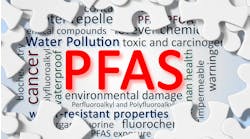Teen Researcher: Nanoporous Materials Could Mitigate Future Oil Spills
The environmental impact from offshore oil spills can persist for decades. Some oil particles lie below the ocean surface, continuing to threaten marine life until they become buried under sediment many years later. When oil spills occur, the traditional clean-up method of using oil booms only removes surface contaminants.
A Greenwich, Connecticut, high school student is making the case for Styrofoam waste as a more effective solution for reducing the impact of future spills. Naomi Park, a 17-year-old student at Greenwich High School won the Environmental Protection Agency’s 2023 Patrick H. Hurd Award at the 2023 Regeneron International Science and Engineering Fair in June. Her project focused on a class of nanoporous materials called hyper cross-linked polymers, or HCPs.HCPs contain properties that bind with nonpolar pollutants like oil and carbon dioxide and can be synthesized using Styrofoam.
Park became interested in the potential of HCPs after she completed a research project in school on microplastics pollution. She wanted to know more about other contaminants that are equally harmful to the environment but receive less media attention. Park said she turned her focus to oil spills after learning about the limitations of existing remediation methods, such as oil booms. In addition to the impact that spills have on marine life, Park’s research unearthed another concern: carbon dioxide. As atmospheric CO2 increases, so do the levels in the ocean.
“When we think about CO2 we think about its effects on the atmosphere; however, upon further research I learned more about ocean acidification, and how it’s an emerging contaminant,” Park explained.
As the project progressed, Park saw an opportunity to address both oil contamination and reduce the CO2 levels in the ocean. It started when she sought nanoporous materials that were less costly and more practical than other types of HCPs that researchers have considered in the past to remove contaminants. She found a paper that detailed a process to create HCPs using Styrofoam waste.
“I was really intrigued because I could potentially be remediating three contaminants: Styrofoam, CO2 as well as the oil,” Park said. “Utilizing the Styrofoam HCPs that were synthesized in a process developed by these researchers, I was able to create an actual implementable framework to remediate these contaminants.”
Park’s material uses a melamine foam base onto which she applies the synthesized HCPs for pollutant capture and removal, according to an EPA news release.
Driving Future Innovation Through STEM Equity
Park was among 1,600 finalists who participated in the EPA’s International Science and Engineering Fair. Chris Frey, the EPA’s assistant administrator for the office of research and development, praised the students for their “creativity, innovation, intelligence, and drive.” He also said he hopes they continue using their STEM (science, technology, engineering and mathematics) talents to tackle environmental issues and develop engineering solutions.
STEM education has become a priority for educators and policymakers to address industrial workforce shortages. Park began her project in an independent science research course led by Greenwich High School teacher Andrew Bramante, who says his students demonstrate a passion for finding solutions to problems.
“These kids are very bright, but they’re not trained like you and I,” Bramante said. “These kids are open books. They can take advantage of those biases not being there, and the creativity really shines through.”
Many of Bramante’s former students have become engineers and entrepreneurs, including one graduate who discovered a way to strip CO2 from flue gases in a factory, he said.
Park said she is trying to patent her HCP technology. She is entering her senior year at Greenwich High School and plans to pursue research-related fields in college, including environmental science and public policy. While Park recognizes the efforts her school has made to advance STEM education, she said these programs should also be accessible to students who are less privileged.
“I think many students would want to get involved in it, but I think it’s also an issue of access to resources,” she said. “I feel like science is going to change the world, so the more people we get involved, the better.”




